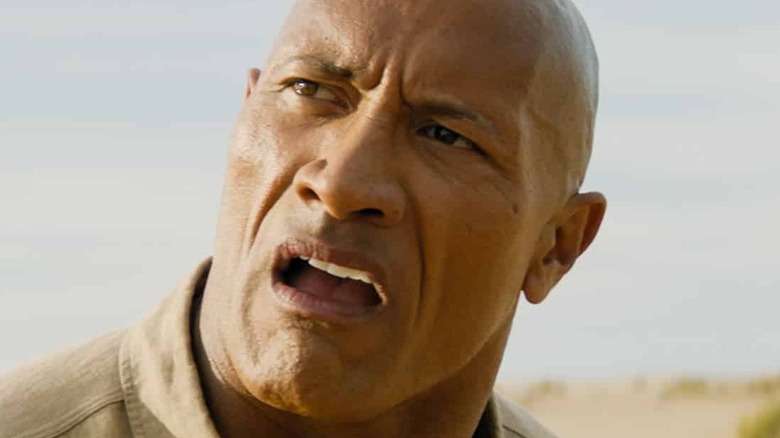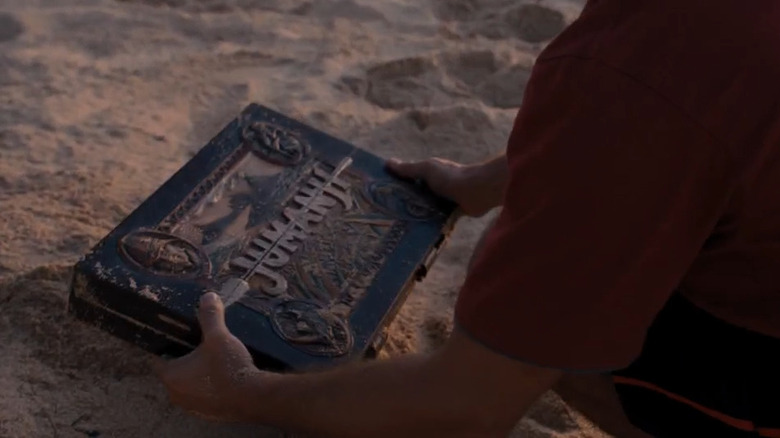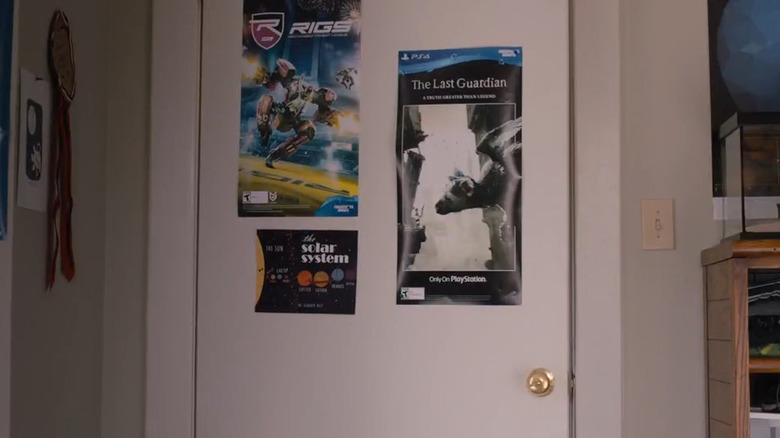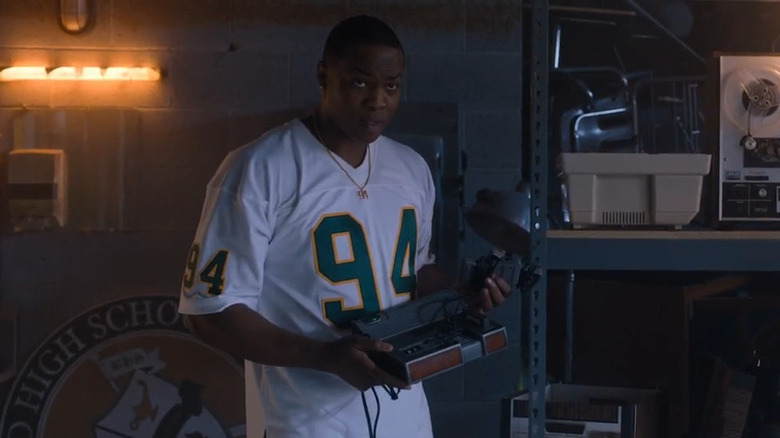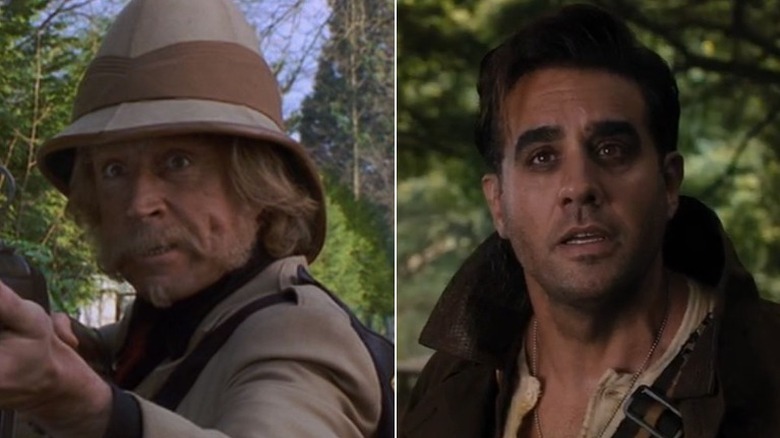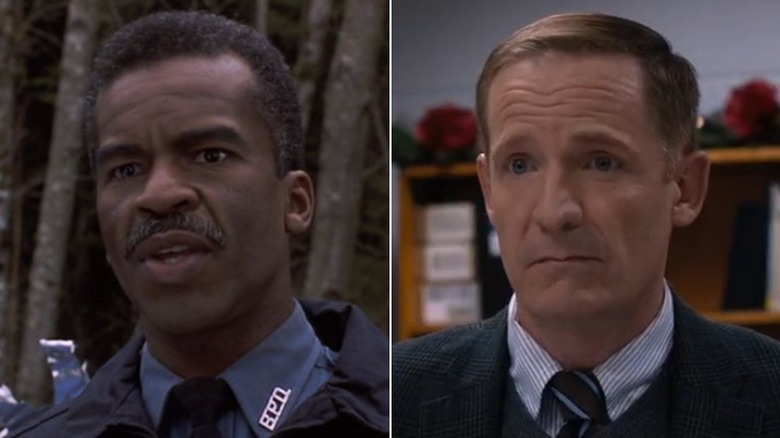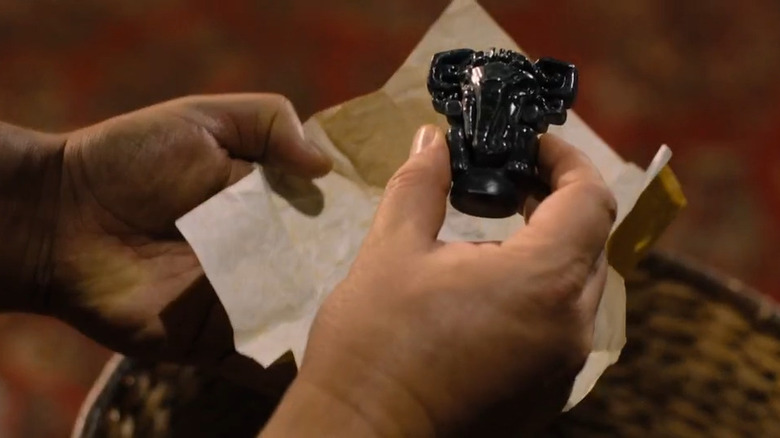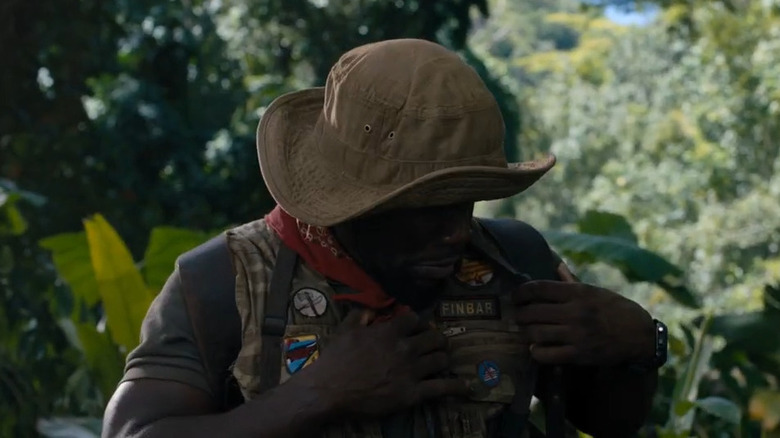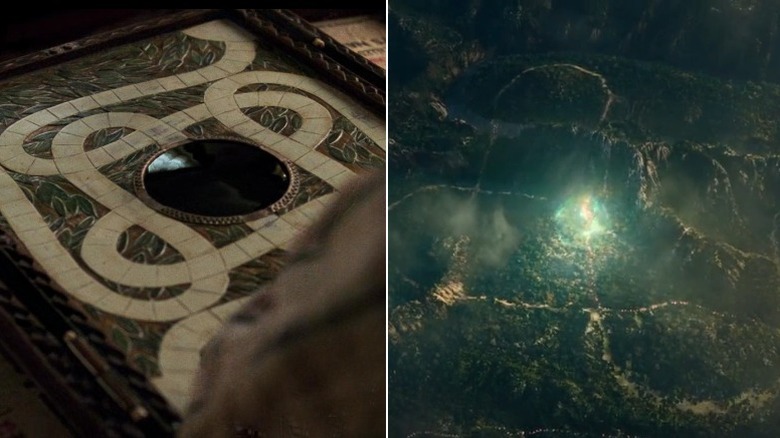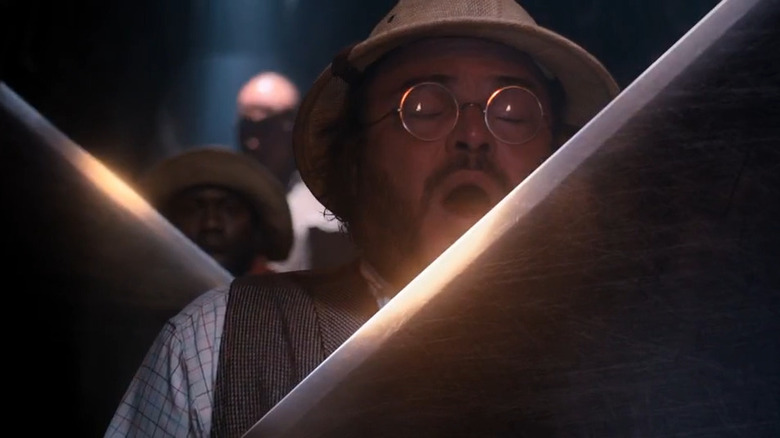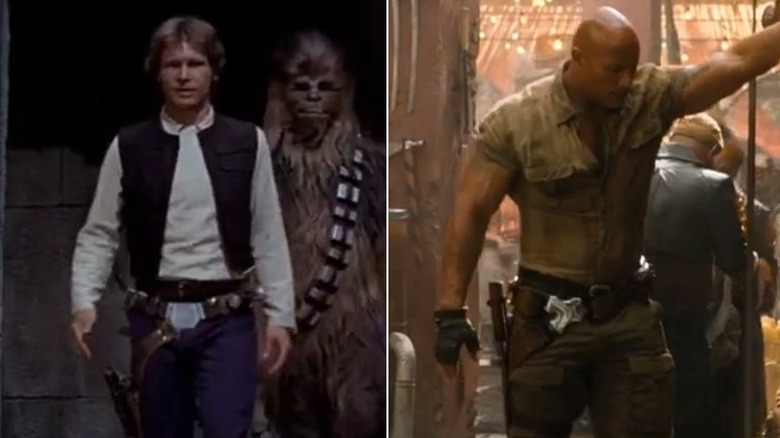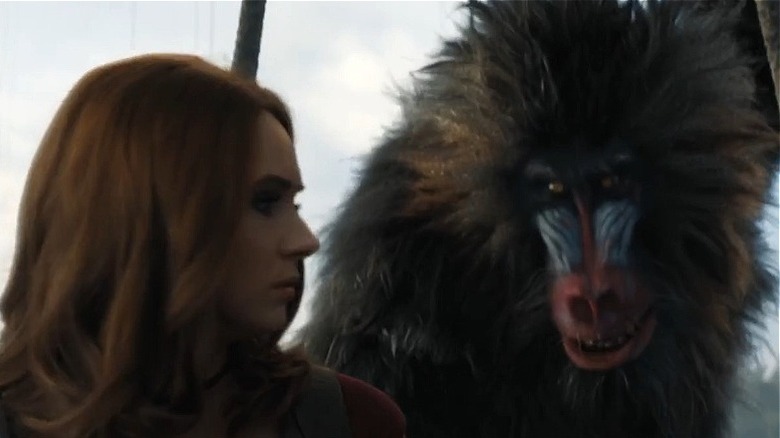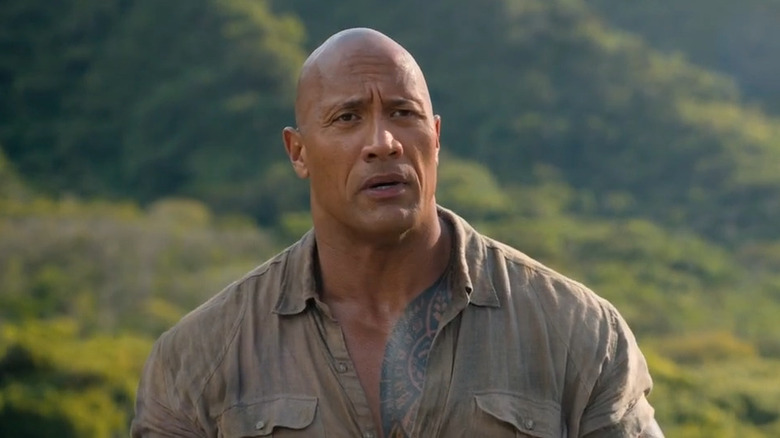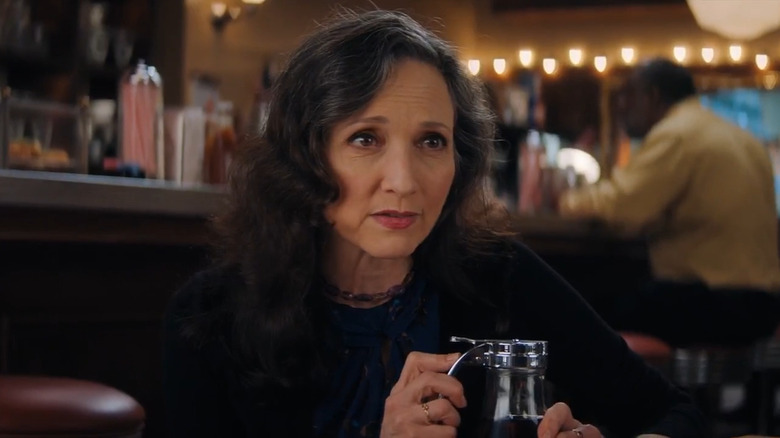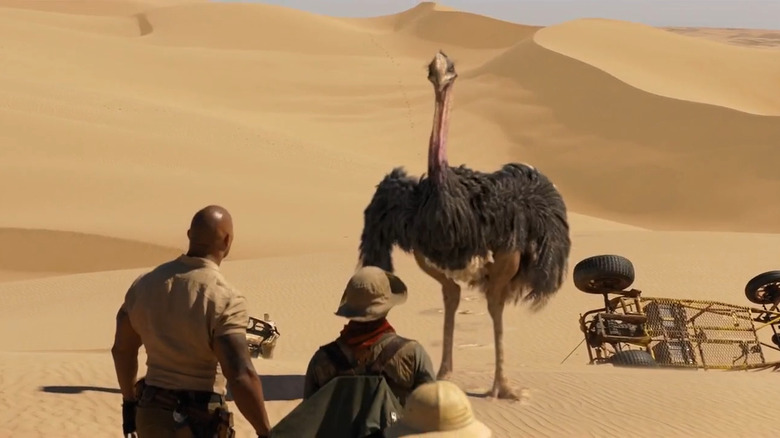Easter Eggs You May Have Missed In The Jumanji Films
The 1995 fantasy adventure film "Jumanji," which is based on Chris Van Allsburg's children's picture book of the same name, introduced viewers to a supernatural board game like no other (except perhaps Zathura, which is a "Jumanji" spinoff). The film kicks off with a flashback to 1869 showing two boys burying the game, visibly terrified by its power, before young Alan Parrish and Sarah Whittle take their first turns a century later. 26 years later, Jumanji falls into the hands of Judy and Peter, who continue the game, inadvertently releasing a now fully grown Alan who's been trapped inside Jumanji all that time. The film sees the trio, along with an adult Sarah, finish the game and reset the timeline.
The 2017 sequel "Jumanji: Welcome to the Jungle" picks up a year on from these events and delivers plenty of Easter eggs for fans of the original film. The most notable is the inclusion of Alan Parrish's (Robin Williams) home in Jumanji, which was a tribute to the late actor. When Spencer, Martha, Fridge, and Bethany find their "missing piece," Alex, he leads them to a "Swiss Family Robinson" style treehouse, which they discover was built by Williams' character. While speaking to The Hollywood Reporter, star Jack Black praised the tribute, saying, "It's like he's there helping us without actually being there."
While this was a pretty obvious "Jumanji" Easter egg, there were plenty of others that were hidden throughout the film and its sequel, "Jumanji: The Next Level," which fans might have missed.
Mr. Vreeke finding the board game on the beach is a direct call back to the 1995 film
In the opening scene of "Jumanji: Welcome to the Jungle," set in 1996, Alex's dad, Mr. Vreeke, finds the Jumanji board game on the beach and brings it home for his teenage son. This scene may seem inconsequential and only important as a way to bring the game back into play. And before viewers are able to think too hard about its meaning, Jumanji demands their attention as it morphs from a board game into a video game in order to pique Alex's interest, which it soon does, kicking off a new Jumani adventure.
However, the brief scene on the beach actually reveals a lot as it's a hidden Easter egg that connects the movie back to its predecessor. At the end of "Jumanji," Alan and Sarah throw the board game off a bridge and into the river where it washes out to sea and, at the end of the film, winds up half-buried on the beach. While it remains mostly hidden, two French-speaking girls are walking along the beach and hear those familiar drum beats. Because they're speaking French, you might think the game has traveled across the world, but it turns out Jumanji never left Brantford. It seems the game remained on the beach until Alex's dad picked it up a year later.
Spencer's poster is an indication of what's to come
After Alex Vreeke gets sucked into Jumanji in 1996, "Jumanji: Welcome to the Jungle" jumps forward 21 years to 2017. In the present, viewers are then quickly introduced to the film's main characters Spencer, Fridge, Bethany, and Martha.
The film introduces Alex Wolff's character Spencer Gilpin first, who is playing a video game while also writing a history essay for Fridge, who will get kicked off the football team if he fails. As he is finishing the paper, Spencer is interrupted by his mom, who barges into his room. The brief conversation is nothing more than logistical chit-chat, which serves to establish Spencer's background. However, there was more to the scene than meets the eye. Eagle-eyed fans of "Welcome to the Jungle" might spot the three posters on the back of Spencer's door that further highlight his passion for video games. The one at the top left of his door, which was only visible for a few seconds before his mom opened the door, was for the video game "RIGS: Mechanized Combat League," which is a virtual reality game.
Although it's a subtle blink-and-you'll-miss-it Easter egg, the inclusion of the poster is definitely a nod to what's to come, as Spencer and his friends get sucked into another reality when they start playing Jumanji. The avatars in both games give each of the players a new, more powerful body.
Fridge's jersey and necklace are the first of many Easter eggs about The Rock
In "Jumanji: Welcome to the Jungle" viewers are introduced to football player Anthony "Fridge" Johnson (Ser'Darius Blain) while he's wearing his Brantford High jersey. It's emblazoned with the number 94, which isn't an insignificant or random number — it's actually the first of many Easter eggs about The Rock hidden within the film.
Back in the day, Dwayne Johnson was a football player at the University of Miami, playing for the Miami Hurricanes while sporting the number 94. The necklace that Fridge wears around his neck in the movie, and its 2019 sequel, is another nod to The Rock's football career as it also displays the number.
As "Welcome to the Jungle" progresses, it continues to poke fun at The Rock. Once they are in Jumanji, Fridge, now played by Kevin Hart, comments on Bravestone's height and weight, using Johnson's real-life measurements. Additionally, when the gang is preparing to return the jewel to the statue, The Rock's avatar, Dr. Xander "Smolder" Bravestone, tries to go it alone, saying, "I'm pretty sure this is a Bravestone thing." He refers to himself in the third person like the actor used to during his wrestling career. Speaking of which, his WWF (now WWE) career began in 1996, the same year Alex was sucked into the game.
Van Pelt gets a makeover
"Jumanji" fans will recall that Alan Parrish's nemesis, who he first met while inside the jungle, was an evil hunter called Van Pelt. He causes havoc once he is released into the real world, even briefly stealing the game away from Judy (Kirsten Dunst), Peter (Bradley Pierce), and Sarah (Bonnie Hunt), before attacking them in a shopping mall. In the 1995 film, the character is played by Jonathan Hyde, who also portrayed Alan's father, Sam Parrish. Although the reason for this is never clarified in the films, it was likely meant to emphasize Alan facing his fears, which was a lesson Sam tried to teach him. The two characters often used the same language about taking things like a "man."
However, Alan defeats Van Pelt when he wins the game, banishing him back to Jumanji. Since he was left alive at the end of the film, it wasn't a total surprise that the creators of "Jumanji: Welcome to the Jungle" brought him back for the 2017 film. However, he has had quite a makeover since we last saw him. Bobby Cannavale took over the role of the vicious hunter, and unlike the 1995 film, the "Jumanji" sequel hones in on his back story. In the cut scene, Nigel (Rhys Darby) reveals that Professor Russell Van Pelt was actually an archaeologist and Dr. Bravestone's former partner. Along with more depth, the character is also given supernatural abilities which only add to his evil persona. Though, of course, he was also eventually defeated at the end of the film, just like Hyde's version of the character.
The Bentley surname sticks around
Van Pelt wasn't the only name that appeared in both the 1995 film and its 2017 sequel; the Bentley surname also stuck around. Viewers first meet Carl Bentley (David Alan Grier) at Sam Parrish's shoe factory. Alan seeks refuge in his company as he tries to avoid his school bullies and the pair bond over Carl's newest shoe design before Alan accidentally ruins it. Later in the film, it's revealed that Carl became a cop after that, but his law enforcement career was only temporary since he continued working in the factory in the revised timeline. Unfortunately, viewers don't see Carl again, but the "Jumanji" franchise would later welcome another Bentley in Brantford.
"Welcome to the Jungle" introduces another character with a surname. On the same day Spencer, Fridge, Martha (Morgan Turner), and Bethany (Madison Iseman) each get into trouble and receive detention, the teacher who dishes out their punishment is Principal Bentley, played by "The Good Place" actor Marc Evan Jackson. Bentley's role in the film is pretty small compared to Carl's, but he is responsible for putting all four characters in the same room where they find the Jumanji video game.
You might be left wondering if Carl Bentley and Principal Bentley are related. However, there's no evidence to suggest this, so the inclusion of the surname is likely just a fun Easter egg for fans — although both characters are connected by the fact that they each represent respective authority figures in Brantford.
The original game pieces make a comeback
In the original "Jumanji" movie, the characters use small animal statues as game pieces. When Sarah, Alan, Judy, and Peter are all playing, there are four statues on the board: a rhinoceros, an elephant, a crocodile, and a monkey. However, these game pieces aren't necessary in "Jumanji: Welcome to the Jungle" since the game has morphed into a video game, and viewers see Spencer, Fridge, Bethany, and Martha each pick up a video game controller when they begin to play the game. Thankfully, the film's creators still found a way to reference the original statues, though. The first to appear is the elephant figurine in the basket at the bazaar. This was Alan Parrish's game piece, so seeing it first became another way to honor Robin Williams. In "Welcome to the Jungle" it is used to represent Alex (Nick Jonas), the missing character who had been stuck in Jumanji for decades, like Alan.
The film's director Jake Kasdan explained that other statues briefly appear as an Easter egg at the end of the film, telling Cinema Blend, "The big statues near the temple at the end, if you look closely they're sort of slightly scary versions of the game pieces." Just after this, there's another reference to Alan Parrish, in the form of the live elephant that Fridge rides. "When you see the elephant, begin the climb," they'd previously been told. This was another way for Robin Williams' memory to be kept alive in this film, and it marked a turning point in the film, too, as the gang came up with a plan to defeat Van Pelt and save Jumanji.
Mouse wears a badge that tells him not to each cake
One of the funniest gags in "Jumanji: Welcome to the Jungle" is Kevin Hart's avatar Franklin "Mouse" Finbar's inability to tolerate cake. "Cake makes me explode," he tells Nick Jonas' character Alex furiously after losing one of his lives in the bazaar. Although viewers already knew that cake disagrees with the character thanks to each of the players' lists of strengths and weaknesses — a hilarious mix-up where Bethany (played by Jack Black) thinks cake is bread means he ends up sampling some.
However, Jumanji tries really hard to tell Fridge that his avatar couldn't eat cake. It isn't just on his weaknesses list — he actually has a physical reminder with him at all times in the form of a badge that is sewn onto his costume. It consists of an image of cake with a solid red line through it, just to make it clear he can't tolerate such sweet treats. Viewers can glimpse the badge any time the camera pans out on Hart's character, though it's most notable in the first scene when they arrive in the jungle.
Mouse's aversion to cake continues in "The Next Level," and eventually seems to extend to the real world, too. At the end of the film, Fridge can't stomach his cake at Nora's. It's possible that the characters are beginning to adopt the strengths and weaknesses of their avatars in the real world. And, if they are, this is likely to foreshadow elements of Jumanji returning to the real world.
The terrain of Jumanji is laid out just like the board game
Fans of "Jumanji" will be able to instantly recognize the winding path of the board game, which loops around before reaching the centerpiece. Although the game transforms into a video game so there is no physical board in "Jumanji: Welcome to the Jungle" — it seems that this iconic pattern is incorporated into the film. In fact, the last shot of "Welcome to the Jungle" reveals that the board has become the virtual world of Jumanji. After Spencer, Fridge, Martha, Bethany, and Alex save Jumanji, the camera zooms out to all of Jumanji. Here eagle-eyed-viewers might notice that the terrain of mountains and land is the same as the interlocking pathways of the board game.
Even when it was a board game, Jumanji was alive, and once inside the jungle, its familiar path became the mountains, the terrain, which surrounded it. With the board game, each turn unleashed creatures or phenomena from Jumanji, like a new level, but in the 2017 and 2019 films, each section of the terrain is a new level, like the bazaar level and aviation checkpoint in "Welcome to the Jungle."
In the film, the jaguar statue represents the middle piece of the board game which presented the clues and riddles to Alan, Sarah, Judy, and Peter. The Jewel of Jumanji, which holds pride of place in the eye of the jaguar statue, is even the same green color as the center of the board, fully illustrating how the game has the ability to change itself.
The Indiana Jones Easter eggs are hidden in plain sight
There are tons of Indiana Jones Easter eggs hidden within "Jumanji: Welcome to the Jungle." It's easy to draw a connection between the two franchises since one is an archaeology and adventure film franchise, and the other is a film about an adventure game with an archaeologist and explorer as one of its avatars. Not to mention the fact that Dr. Bravestone's entire persona is based on Harrison Ford's iconic character. Dwayne Johnson, who played Bravestone, is a self-proclaimed Indiana Jones fan, and he had a lot of fun drawing on Ford's film franchise for inspiration. He admitted to Global Grind that his eight-year-old self found the films so inspiring. "I thought, 'Wow, I want to do that.' Not necessarily I want to be an actor, but I want to be that guy. Like, that guy's cool. That's why there's nods in the movie to Harrison Ford and to that movie, like I have my hat," he explained.
Alongside Johnson's love for Indy, there's also a personal connection linking the two franchises. "Welcome to the Jungle" and "The Next Level" had Jake Kasdan, the son of "Raiders of the Lost Ark" writer Lawrence Kasdan, at the helm. Viewers can see this connection shine through in the scene where Alex guides the gang through the booby-trapped tunnel and when Karen Gillan faces a pit full of snakes. Having venom as her weakness is another nod to Indy. In the sequel, the scene where mandrills are chasing the group along the rope bridge comes to a climax when Eddie (as Bravestone) cuts it in dramatic Indiana Jones fashion, paying homage to "The Temple of Doom."
The Rock planted a Harrison Ford Easter egg of his own
Of course, Jake Kasdan's "Jumanji" films don't just plant Harrison Ford Easter eggs through Indiana Jones references. Dwayne Johnson told Global Grind that he also planted a "Star Wars" Easter egg in Bravestone's outfit, which is a nod to Ford's character, Han Solo. The item in question, of course, is Bravestone's belt and machete holder, which he wears around his waist, slung to his right side. "This is such a dorky thing, but like, this [grabs machete holster], this is my nod to Harrison in Star Wars," Johnson explained proudly. "So, just this and it's kind of like slung real low. There's like little things, little Easter eggs," he said.
In the original "Star Wars" trilogy, Solo is rarely seen without his holster, which has a large hexagonal metal buckle with three leather straps feeding into the front of it. Also hung on his right side, it holds his blaster. Bravestone's belt and machete holster have a similar style and appearance, but rather than the brown leather of Solo's, which stands out, it is a darker gray/green color to be more camouflaged.
The mandrills in The Next Level are a nod to the monkeys in the original Jumanji
"Jumanji: The Next Level" brings an increased risk and sense of danger for the main characters, and one of the levels that they face early on is the mandrills, which chase them across a series of rope bridges. The moving rope bridges themselves are a nod to the ever-changing staircases in "Harry Potter," but the stars of the scene are the CGI mandrills.
Speaking to Befores And Afters, visual effects supervisor Ken McGaugh explained that the mandrills they created are very different from the real animal. "They're based off of concept art, not from reference. Our mandrills actually have tails, and the proportions are quite a bit different. We just had to go with our gut on making them look aggressive — we referenced a lot more baboons because baboons are more aggressive," he explained.
In the scene, they aggressively chase each of the characters, even successfully throwing Karen Gillan's character off one of the bridges, cutting one of her lives short. This scene is a callback for fans of the original "Jumanji" movie, who will remember when hoards of monkeys took over Judy and Peter's house, and later the town after they started playing the game. "This will not be an easy mission, monkeys slow the expedition," Peter reads after he rolls his turn. That sentence is mirrored by the gang's encounter with the mandrills. The scene also a dig at the CGI of the time, which director Joe Johnson admitted was one of the biggest challenges of the 1995 film.
Bravestone's Spider-Man connection
Dr. Smolder Bravestone's backstory has a connection to "The Amazing Spider-Man" films through writer Jeff Pinkner. He co-wrote both franchises, so it's no surprise that Dwayne Johnson's character has a remarkably similar backstory to Peter Parker, with both their respective parents being murdered while they were only young boys. Like Peter Parker, who becomes New York's friendly neighborhood hero Spider-Man, Bravestone also becomes a hero. However, he does this as an archaeologist and adventurer.
Viewers don't learn much about Bravestone's backstory in "Jumanji: Welcome to the Jungle," but in the 2019 sequel, the cut scene reveals a lot about his past. As Nigel narrates, viewers learn that Bravestone's parents were brutally murdered by Jurgen the Brutal (Rory McCann). Similarly, "The Amazing Spider-Man 2" revealed that Peter's parents were targeted and murdered for trying to keep important data out of the wrong hands. The one thing the cut scene doesn't reveal is why Bravestone's parents were killed, but if it is in keeping with the "Spider-Man" theme, it's possible they were trying to keep a powerful object safe. What we do know, thanks to The Rock, is that Jurgen's story is just beginning. "Cool plot twist about JURGAN (for those who caught it) is he's an actual avatar in the game. Meaning – SOMEONE is playing him. But who? That's the big mystery. In the next JUMANJI we'll find out just who's been playing the JURGAN THE BRUTE," he wrote on Instagram. Perhaps by learning more about Jurgan, viewers will learn more information about his past with Bravestone's parents.
Nora returns
Nora Shepherd (Bebe Neuwirth) first appears in the 1995 "Jumanji" movie as the loving aunt of Judy and Peter. Although she does her best to take care of them, she's not afforded a very kind fate, as viewers last see her when Peter locks her in a cupboard — for her own protection, of course. Then the timeline resets and Judy and Peter save= their parents, which means they never go to live with their aunt Nora, so it is safe to assume that she has gone back to her life as it was before her brother and sister-in-law died and she takes her niece and nephew in. However, there was never any confirmation of this until her character returns briefly at the end of "Jumanji: The Next Level."
The return of Nora Shepherd is the biggest connection between the original "Jumanji" movie and its newer sequels. As we learn that she is a longtime friend of Eddie's, and the proprietor of the restaurant Nora's, we finally learn what happened to her after the timeline reset. It appears that she moved to Brantford anyway. Whether she did so at the same time she would have moved with Judy and Peter isn't clear, but since she's been friends with Eddie for decades, she'd definitely been in town for a while.
Director Jake Kasdan told The Wrap that trying to bring Nora back felt very "Back to the Future" for him, but that "it's also important for us to try where we can to make that happen because we have a lot of reverence for that movie and I think it's a stronger methodology if they do connect." It's safe to say the fans were happy!
The ostriches in Jumanji: The Next Level are a callback to the original film
There is no shortage of aggressive or dangerous animals in any of the "Jumanji" films — from the stampede of rhinos or aggressive crocodile in the 1995 film to the venomous snakes and deadly mosquitoes of the 2017 sequel. The third installment in the "Jumanji" franchise (or fourth if you're including "Zathura") welcomes even more like the ostriches, which are the first level in Jumanji. After Martha, Fridge, Eddie, and Milo are dropped into the dunes of the desert, they quickly find themself trying to outrun the flightless birds in dune buggies with mild success.
They eventually escape the ostriches when Alex and Bethany (who's temporarily a horse) show up and scare them away. However, that's not the last viewers will see of them. In the mid-credits scene to "The Next Level," "New Girl" star Lamorne Morris as "the heater guy" who finds the Jumanji game in Spencer's basement. Intrigued, he touches it, and the scene cuts out, and the next minute a flock of ostriches stampedes down the main street. Not only does this scene serve as a callback to the aforementioned rhinos which careered around Brentwood in the original film, but it brings Jumanji back out into the real world, just as it was in the 1995 film. This was probably a result of the game having been broken and Spencer's efforts to fix it at the beginning of the film, but (if and) when "Jumanji 4" finally graces the silver screen, it's likely to have a real-world setting like the original film.
